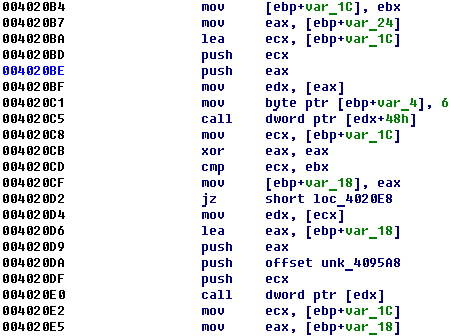Complete Trojan Analysis We used IDA Pro to disassemble both trojan components.Part 1 The first part is small and trivial to analyze. It displays a message box saying "Error on line 25: invalid object" and, when the user clicks OK, connects to http://view-greetings-yahoo.com to download sysman32.exe into the system directory. It then creates a registry key in the well known Software\Microsoft\Windows\CurrentVersion\Run registry branch to run at the next reboot. You can find the full analysis of Part 1 here as an IDA 4.5 database or a text listing. Part 2The main trojan executable was more challenging and interesting because
We used proprietary in-house tools to handle the unpacking and analyze the COM interface calls. The Part 2 IDA Pro 4.5 database and a text listing are available. Here is a sample of the raw code 
Discussion The trojan uses the COM interface to get information from all open browser windows. To get a pointer to the IShellWindows object which represents all browser windows it calls CoCreateInstance with the class id value for IShellWindows: {9BA05972-F6A8-11CF-A44200A0C90A8F39}
The algorithm that steals the web browser information is as follows For each browser window
The most time consuming but essential phase of the analysis is finding out the object and function names from their magic class IDs. While the object names have to be defined manually, the function names can be recovered by the IDA type system. The type library vc6winr.til contains information about common windows object virtual tables (vtbls). In order to replace call [ebx+8] with something nice like call [ebx+IShellWindows.Item] we add the corresponding virtual table definition from the type library to the database and then use the "structure offset" command to convert the number into a nice function name. The virtual tables usually have a class name postfix with "Vtbl". For example, the virtual table for the IShellWindows class is IShellWindowsVtbl. In practice, we have automated this procedure with a plugin. What can't be yet automated is the "structure offset" command since IDA doesn't trace the data flow in programs. The user must still locate the call [ebx+N] instructions and convert them to a meaningful representation.
|